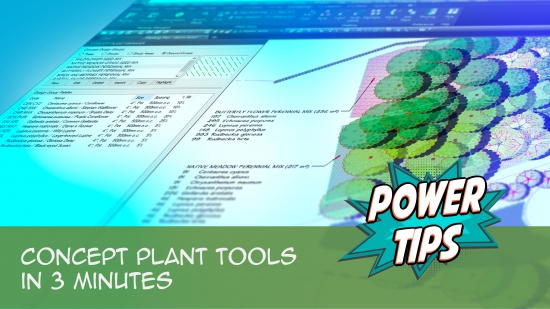Create a Mix of Multiple Seeds or Plant Species
Quick video
- Creating a Plant or Seed Mix
- Placing a Plant or Seed Mix in Your Drawing
- Calculating the Area of Your Plant and Seed Mix In Your Drawing
- Labeling Plant or Seed Mixes
- Deleting a Plant or Design Group
- Plant Mixes in Schedules
- Converting Concept Plants to Project Plants
- Creating a Modular Planting Mix
- Troubleshooting
- Related Webinars
Landscape designs will often require you to include a mix of several plant species within a single planting area. For Shrub Areas or groundcovers, you may want to represent this mixture of plants, sods, or seeds with a single hatch. You can create and place your own custom plant mixes using the Concept Plant Manager. This feature give you total control over your plant mixtures, including the ability to set the percentages of each plant or seed manually.
We made some major updates to the functionality of Concept Plants in 2018. The crux of the update was to engineer an option to include Concept Plants in the regular Plant Schedule. You can now drag and drop plants into the Concept Palette from the Plant Manager to build your palette. You can also move between a Concept Schedule and a regular Plant Schedule with a few clicks, showing all individual plants, configured perfectly with your assigned percentages – plus it even auto-assigns percentages if you didn’t. This is wildly awesome capability, all driven by numerous amazing wishlist requests over the years.
Creating a Plant or Seed Mix
Quick video
You can create your own plant or seed mixtures in the Concept Plant Manager, also known as the Concept Manager.
Note that you can no longer change ths symbol by clicking it. This change was necessary for multiple reasons. We've added new functionality that allows you to double-click this image to place the selected Concept Plant. You can use the New or Edit buttons to assign a new symbol.
Open the Concept Manager:

F/X Planting ribbon, Concept Plant Manager flyout
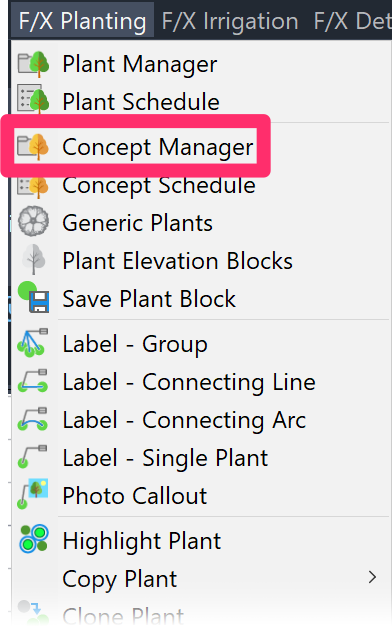
F/X Planting menu, Concept Manager option
or type ConceptPlants in the Command line
The Concept Manager for your project will open.
To create a new plant or seed mix, select a plant category (example: Ground Covers), and click the New button in the middle of the Manager, under Plant Design Groups.


The Concept Plant Info dialog box will open.
Type a name for your mixture (Example: GRASS MIX).
Type any necessary notes for your mixture, and click OK.
The Planting dialog box will open.
Select a hatch to represent your plant or seed mixture, then click OK.
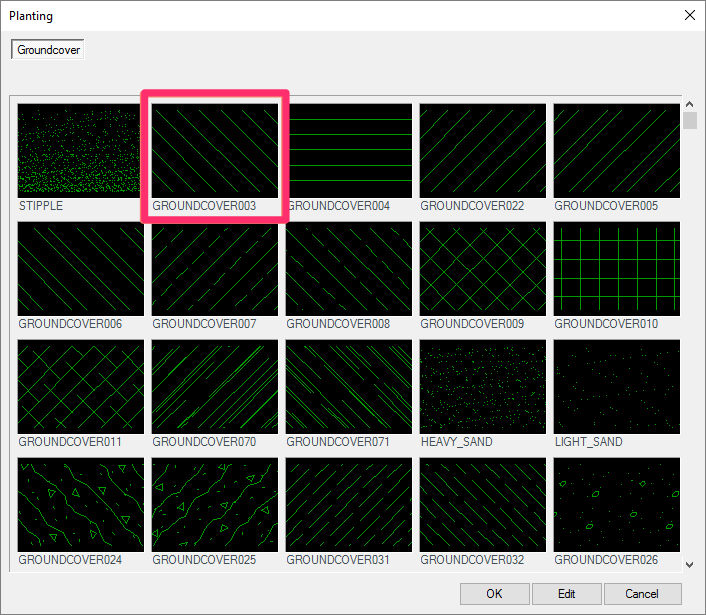

The new mixture category will be added to the Concept Manager.
To start adding specific plants or seeds to the mixture, click the New button at the bottom of the dialog box, under Design Group Plant Palette.
You can also build your palette by dragging and dropping plants directly from the Plant Manager into this list.
The Add Plant dialog box will open. Locate and select the plant genus, species, and variety you want to add to your mixture (example: Arrhenatherum bulbosum, or Bulb Oat Grass). Click Add to Project.

Continue adding the remainder of the plants or seeds in your mixture in this way. Close this dialog box or click Done when finished.
The plants you added to the project will all be listed in the Design Group Plant Palette for your mixture group.
You'll also see a thumbnail image of the hatch pattern you selected above.
This hatch will represent the entire mixture when placed in your drawing.
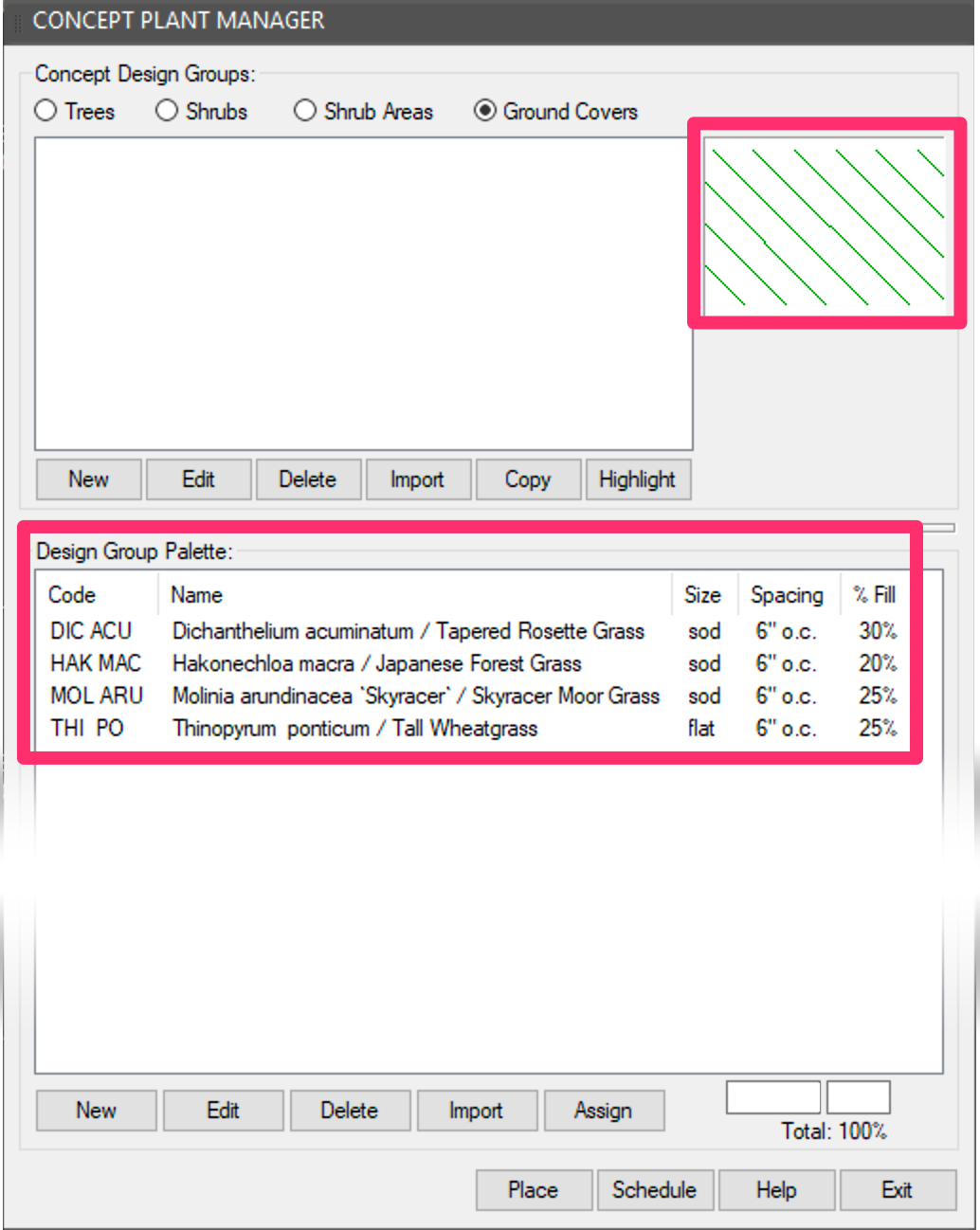
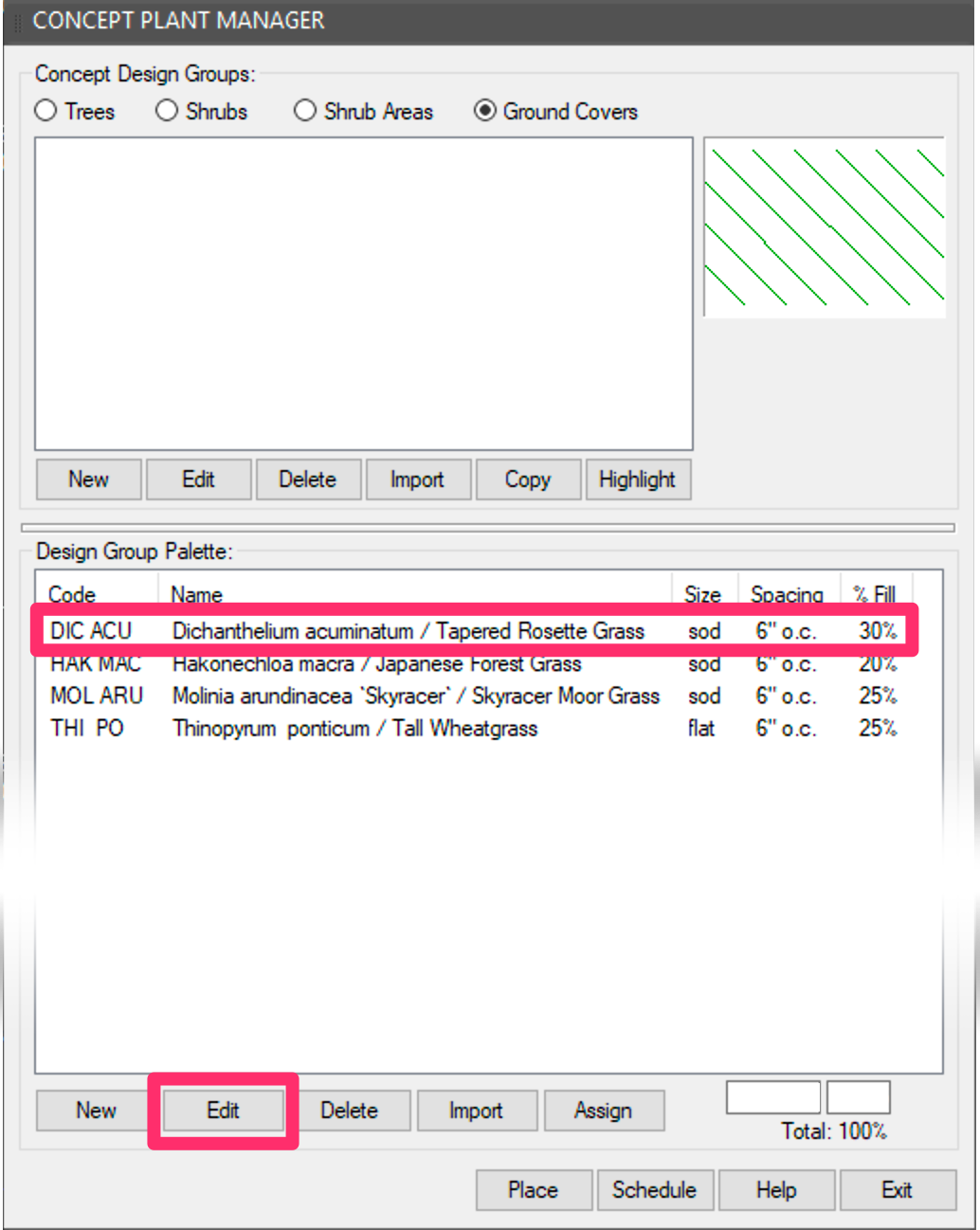
Now it's time to add the percentages of each plant or seed in your mixture.
To add a percentage for a plant, select that plant in the list and click Edit.
The Plant Info dialog box will open.
The Container/Rootball Size menu allows you to set a container size. It also gives you options for adding the plant such as flat, sod, seed.
In our example, we'll add our plants as sods.
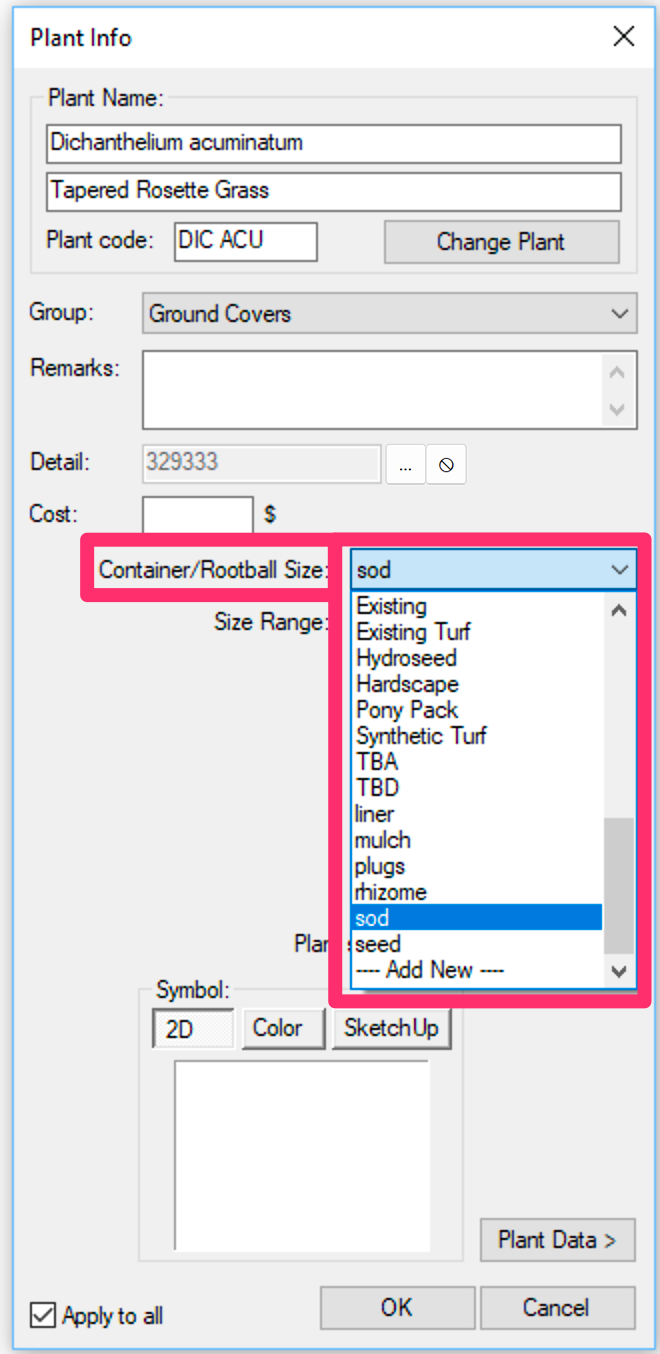
Plant Spacing & Percentage Fills
You can enter Plant Spacing and Percentage Fill values for you plant, sod, and seed mixes.
Calculating Square Area Only:
To calculate a plant in square area only, leave the >Plant spacing field blank, but fill out the >Percentage fill field.>
Calculating Plant Quantity:
To show the actual quantity of plants in your mixed area, fill out the Plant spacing field (example: 106 inches), as well as the Percentage fill field.
The system will use the values from the two fields to calculate the number of plants needed to satisfy these conditions, using our Natural Spacing formula.

Our Natural Spacing Formula
Here's a formula you can plug into MS Excel if you need figure out the needed spacing when you only know the needed density (#/area):
=ROUND(1000 * SQRT(1 / (A1 * 0.866 * 1.1111)), 0)
(Where A1 is number of plants in the density, and the density is per square meter.)
Take out the "1.1111," and you get triangular spacing. The 1.1111 is for natural spacing.
Notes on percentage fills:
- The percentage will automatically display in red if the number exceeds 100%, but you can go to as high a total percent fill as you need. This is a great trick if you need to include a complete 100% underseeding along with your mix of plants. The individual plant quantity totals will still calculate correctly if the overall percent fill exceeds 100%.
- Mix percentages now support decimal numbers, allowing you even more precision in creating your fills.
- See our creating a modular planting design documentation to learn a method for calulating percentage fill for individual trees and shrubs placed in a planting area.
If you group two or more plants or seeds together, you can enter a percentage for each to reach a total of 100 percent.

In the example to the left, we've assigned a percentage to each of the four plants making up this Design Group:
- Dichanthelium acuminatum: 30%
- Hakonechloa macra: 20%
- Molinia arundinacea 'Skyracer' 25:%
- Thinopyrum ponticum: 25%
See our Concept Plant Manager page for more details on spacing options for Concept Plant groups.
Copying an Existing Design Group
You can also create a new Design Group based on an existing one and all the plants already in it.
Highlight the Design Group you want to copy, then click Copy.
You can now proceed with our steps to add a new mix. You'll now have a new Design Group that includes all the plants in the copied group. You can add and delete plants as necessary, give the group a new symbol, and configure any other data you need to add.
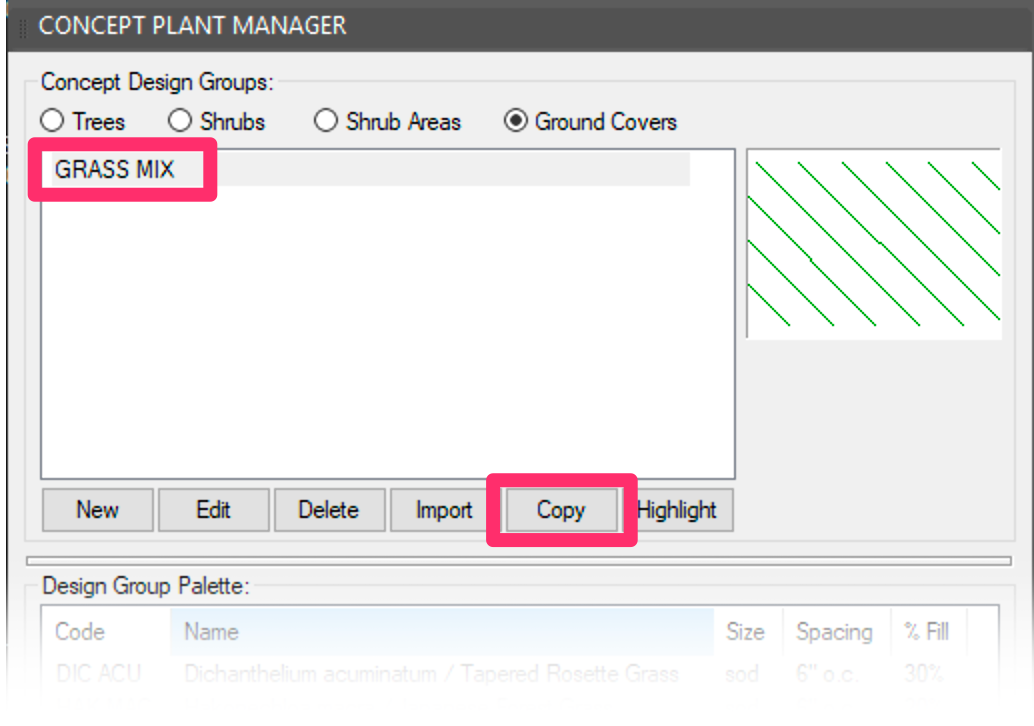
Placing a Plant or Seed Mix in a Drawing
Placing a plant or seed mix is the exact same process as placing a Concept Plant.
To place your mixture in your drawing, highlight it in the Concept Plant Manager and click Place.
You can also place your mix by double-clicking its symbol thumbnail in the top right corner of the Concept Plant Manager.
As with placing other plants or hatches, you can select an existing closed polyline or draw a new one to contain your hatch. A hatch will be placed in your drawing that represents your entire seed mixture.

Want to use our Exclude Shrubs tool? It will work with Concept groundcovers, but only manually – and only with shrubs you've added and placed from the Plant Manager. When you're about to place a concept groundcover, press the E key to trigger the Exclude Shrubs option when you place the groundcover. Note that Exclude Shrubs will not recognize and exclude individual Concept shrubs.
Calculating the Area of Your Plant or Seed Mixture in Your Drawing

To determine the area of your mixture you've placed in your drawing, you can place a Concept Plant Schedule by clicking the Schedule button in the Concept Plant Manager.
The Concept Plant Schedule will show the total area of your plant or seed mix you've placed in your drawing. It will also list and automatically calculate each component of your seed mixture from the various areas where you've placed it in your drawing. In another column, it will show the plant or seed percentages and container sizes of each plant (or whether you've placed the plant as seed, sod, or flats).
Here's an example of a Concept Schedule we would generate with the sod mix we've created:

Labeling Plant or Seed Mixes
Ready to label your plant or seed mixes? Follow our instructions for labeling Concept Plants.
Deleting a Plant or Design Group
Deleting a Plant
To delete a plant from one of your groups, highlight it in the Design Group Plant Palette area and click Delete.

You'll be asked whether you're sure you wish to delete the plant.
Click Yes to delete the plant. Click No to keep it.

Deleting a Design Group
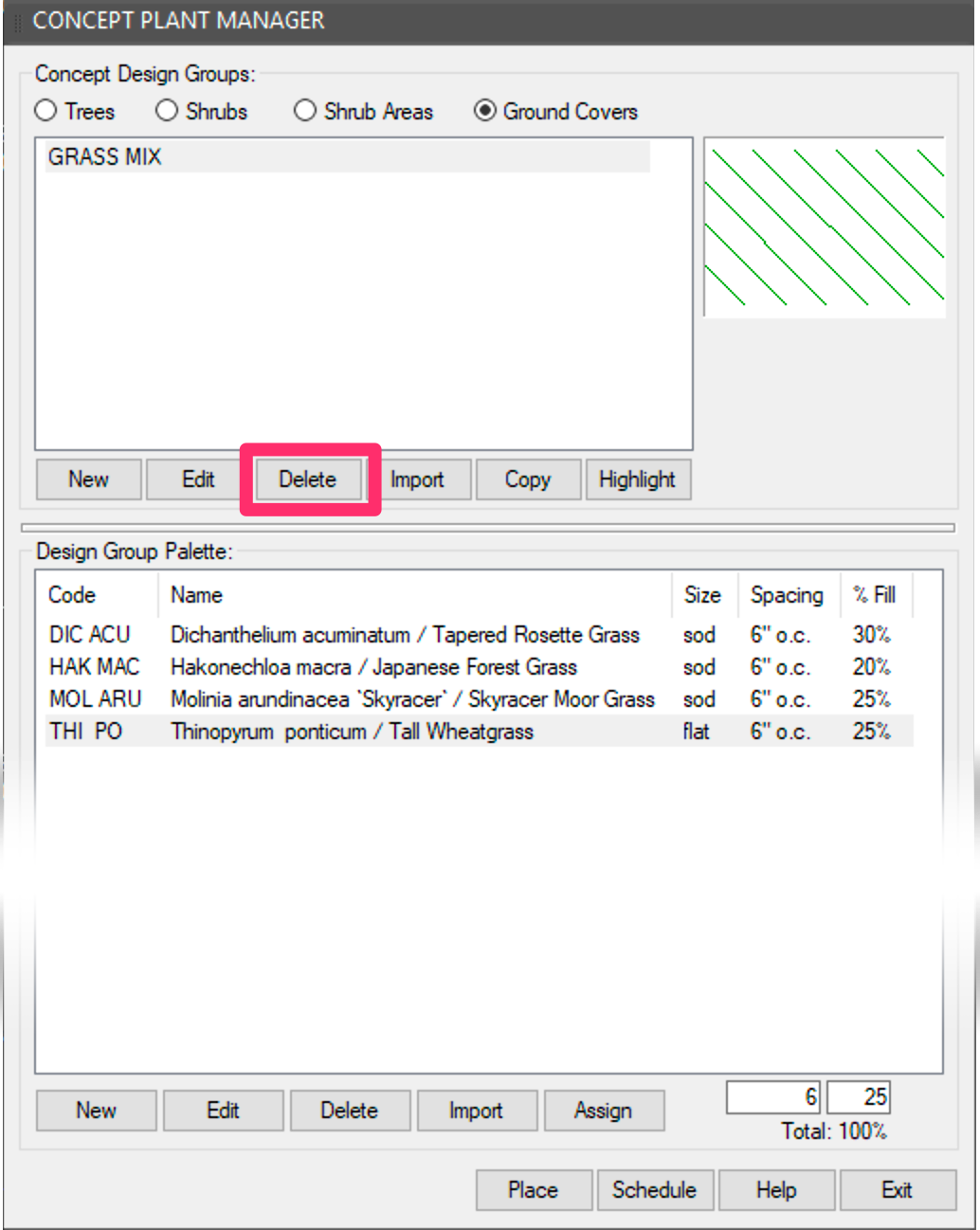
To delete an entire Design Group, highlight it in the Plant Design Groups area and click Delete.
You'll be asked whether you are sure you wish to delete the plant.
Click Yes to delete the plant. Click No to keep it.

Plant Mixes in Schedules
You have a couple of options for showing your Concept mixes in a schedule:
- You can use the Concept Schedule to provide a list of your plant mixes.
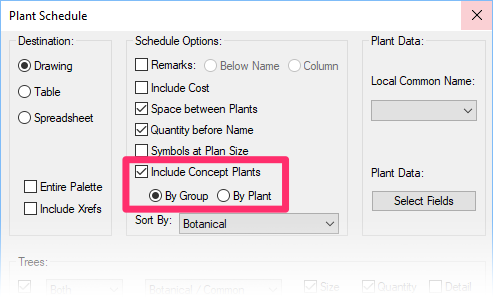
- You can also include your Concept mixes and plants in the design Plant Schedule by choosing to Include Concept Plants by group or by plant in the schedule options.
Converting Concept Plants to Project Plants
When you create a concept plan, the ultimate goal will be to convert your Concept Plants to project plants (that is, actual plants that you've added to your plant palette). In the interest of avoiding confusion, it's a good idea to select new symbols for the project plants when you make the conversion. Thus, we recommend selecting Concept Plant symbols that you will be unlikely to use in your actual planting plan.
Create a Modular Planting Mix
Modular planting design allows designers to apply their knowledge of successful plant communities to their landscape plans, resulting in highly effective designs at a reduced cost. Our Concept Plant mix tools greatly simplify this process. Find out how.
Related Webinars
- Concept Planting Tools: Learn all about this valuable set of tools, which allow you to set up an initial planting plan – even before you’ve built your palette. (1 hr 1 min)
- Planting F/X for Beginners Part 2: In this second installment, we'll dive right into some of the tools you need to know about for the best experience and fastest workflow when starting with Land F/X planting plans, including Concept Plants and plant mixes. (1 hr 3 min)
- Modular Planting Design: If you’re trying to design with plant communities, have you tried using the plant mix tools in our Concept Plant Manager? Tune in to see how these tools simplify this planting design process dramatically – including the details. (1 hr 1 min)
Troubleshooting
Issue: One or more of your Concept Design Groups are missing from the Concept Plant Manager


